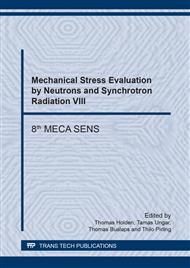p.52
p.60
p.66
p.74
p.83
p.91
p.101
p.107
p.114
A Comparison of the Constitutive Response of Austenitic and Ferritic Steels under Welding Processes
Abstract:
The need to accurately measure and predict weld residual stresses (WRS) has led to several examinations intent on developing best-practice guidelines in the assessment of welded structures. The present investigation examines two benchmark weld specimens; both specimens are autogenous edge-welded beams, with welds deposited using a mechanised tungsten inert gas process. However, one of the beams was made from AISI 316LN austenitic steel, while the other was made from SA508 Gr.3 Cl.1 ferritic steel. Considerable differences in the cross-weld residual stress profile were observed between the two beams, prompting a detailed examination of why such differences exist. Computational weld mechanics was used to assess both processes; model validation was achieved using previously reported WRS and micro-hardness measurements. A comparison of the numerical solutions indicates that the shape misfit resulting from a sharp weld-induced thermal gradient causes significant longitudinal tensile stresses in the heat-affected zone in both specimens. The presence of influential solid-state phase transformations in the ferritic specimen leads to the formation of compressive stresses in the weld metal, while the stresses remain tensile in the weld metal region of the austenitic specimen. The compressive stresses in the ferritic specimen serve to offset the tensile stresses in the HAZ, leading to a reduction of the self-equilibrating WRS present in the ferritic parent metal.
Info:
Periodical:
Pages:
83-90
Citation:
Online since:
August 2017
Authors:
Price:
Сopyright:
© 2017 Trans Tech Publications Ltd. All Rights Reserved
Share:
Citation:


